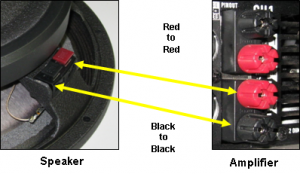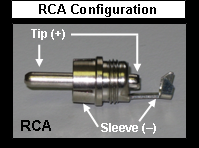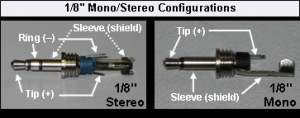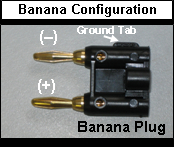Speaker Test / Polarity / Pin-Outs
What is Polarity? It is important to understand Polarity when performing a speaker test. In this menu page you will learn that Polarity refers to the position of the “positive or hot” (+) and the “negative or common” (–) signals in an audio system. It is the part of the signal (waveform) that is currently “active.” Connectors will designate which pin is “hot” and which is “common” and some connectors will also designate “ground” (where the shield wire should connect). Speakers will usually have red and black connectors (or markings, dots) on them to designate polarity.
Speaker / Amplifier Polarity Notes
Speakers will have red and black connectors (markings or dots) to designate polarity (this is so you will connect all of your speakers the same way). Why? When speakers are connected the same, then all the speakers will move “in and out” at the same time, when this occurs, the speakers are said to be in polarity.
Basic Pin configurations on Connectors
Using the XLR example – The pin configuration is Pin 1 = Shield, Pin 2 = Hot, and Pin 3 = Common.
On the 1/4″ Mono example – the Tip = Hot, Sleeve = Common and On the 1/4″ Stereo (TRS) example – the Tip = Hot, Ring = Common, and the Sleeve = Shield (Ground).
 |
CHECK OUT OUR NEW “TECHNICAL” PUBLICATIONS NOW! |
 |
On the RCA example – the Tip = Hot, Sleeve = Common
On the 1/8″ Stereo (TRS) example – the Tip = Hot, Ring = Common, and the Sleeve = Shield (Ground) and On the 1/8″ Mono example – the Tip = Hot, Sleeve = Common
On the Banana Plug example – Ground Tab Side = Common, Other side – Hot
Conclusion
All guitar or bass players should understand the basic Polarity and Pin Outs of connectors in order to perform proper speaker testing.
A poorly soldered connector can cause a “short” to occur, or a “cold” solder joint can cause an “open” to occur (and other intermittent types of problems). For example if you solder a ¼” mono connector and use it for a speaker connection – and you happened to put too much solder and the (+) connection is now touching the ( – ) connection – this is considered a “short.” Then when you plug this “shorted” connector into the back of an amplifier you are basically going to “short out” the output of the amplifier (causes it to overheat, and possibly smoke / burn up).
Hooking up a speaker with reverse polarity can cause “havoc” with your PA system. For example if you have two subwoofers hooked up correctly (+ to + and – to – ) try taking one of them and hook it up using reverse polarity ( + to –, and – to + ). You will hear a lot of “cancellation” taking place. One subwoofer is now moving outwards while the other subwoofer is now moving inwards – this causes the signals (or part of the signal) to cancel out.
Note: If you own JBL Speakers, you should read the technical data sheet that comes with the speakers. JBL speakers (at least the Professional model cabinets are usually connected “internally” in reverse polarity). As long as you don’t open up the JBL speaker cabinet and change any of the wiring, you will be fine.
Take the time to learn and understand Polarity and Pin Outs basics of connectors and polarity – it could save you a lot of time and money in the long run…

BASIC AUDIO TEST EQUIPMENT INFO HERE!





